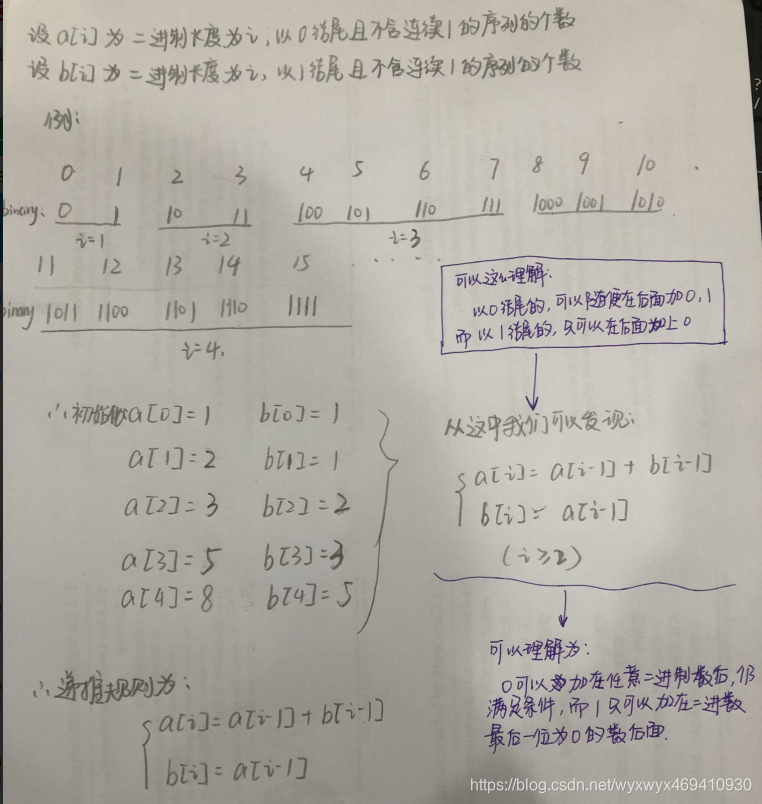Leetcode 600. Non-negative Integers without Consecutive Ones
题目:
Given a positive integer n, find the number of non-negative integers less than or equal to n, whose binary representations do NOT contain consecutive ones.
Example 1:
Input: 5
Output: 5
Explanation:
Here are the non-negative integers <= 5 with their corresponding binary representations:
0 : 0
1 : 1
2 : 10
3 : 11
4 : 100
5 : 101
Among them, only integer 3 disobeys the rule (two consecutive ones) and the other 5 satisfy the rule.
Note: 1 <= n <= 10^9
解法:
先理解一下题意:大概意思是说找一下小于等于 N 的数里面有多少个数表示成二进制形式之后,不会有连续的两个 1 出现在其二进制序列里面。
先说一下我最开始的想法:
从 0 到 N 遍历 N 个数字,将小于等于 N 的每一个数字用bitset表示出来,然后用一个循环从bitset的0位置开始将相邻两位相加,观察结果是否会有 2 出现,如果出现就证明不满足题意;如果遍历完没出现,就让统计值 +1 ;
这种方法是可以求出最终结果的,但是会超时!所以直观的方法行不通!
如图:

另寻他路
在网上查看大佬们的解题思路,有一种比较巧妙的方法介绍一下:

最后我们所要求的结果是:
total = a[i-1] + b[i-1]( i 在这里指数字转二进制后的长度)
但是我们使用的这种方法会有多算的情况,比如当我们输入 8 或 9 时候,其二进制长度都是 4 ,所以我们在计算小于等于 8 的满足题意的数字的时候,可能会把 9 10 都算进去,所以我们要把多余的情况减掉。
那具体应该怎么减去这些数字?
假如我们要计算 num = 8 的情况,那么当长度等于 4 时候,则 0、1、2、4、5、8共 6 个数字满足题意,但是total = a[3]+b[3] = 8 ,多余的情况为 9 = 1001(2) 、10 = 1010(2) ;
我们算法最初开始在生成二进制数字时候,是逆序生成的,也即 8 = 0001 ,所以我们可以从待测序列的倒数第二位往前算
- 如果位置
j和位置j+1上的数字都是 0 ,那么就在total中减去b[j]; - 如果位置
j和位置j+1上的数字都是 1 ,那么直接退出
这里之所以减去 b[j],因为在位置j上可能会出现满足题设要求的 1 ,而在 1 位置上满足情况的个数为 b[j]
代码:
class Solution
{
public:
int findIntegers(int num)
{
int n = num;
string t = "";
while (n > 0)
{
t += (n & 1) == 1 ? "1" : "0";
n = n >> 1;
}
vector<int> zero(t.length() , 0), one(t.length(), 0);
zero[0] = one[0] = 1;
for (int i = 1; i < t.length(); i++)
{
zero[i] = zero[i - 1] + one[i -1];
one[i] = zero[i - 1];
}
int res = zero[t.length() - 1] + one[t.length() - 1];
for (int i = t.length() - 2; i >= 0; i--)
{
if (t[i] == '1' && t[i + 1] == '1')
break;
if (t[i] == '0' && t[i + 1] == '0')
res -= one[i];
}
return res;
}
};